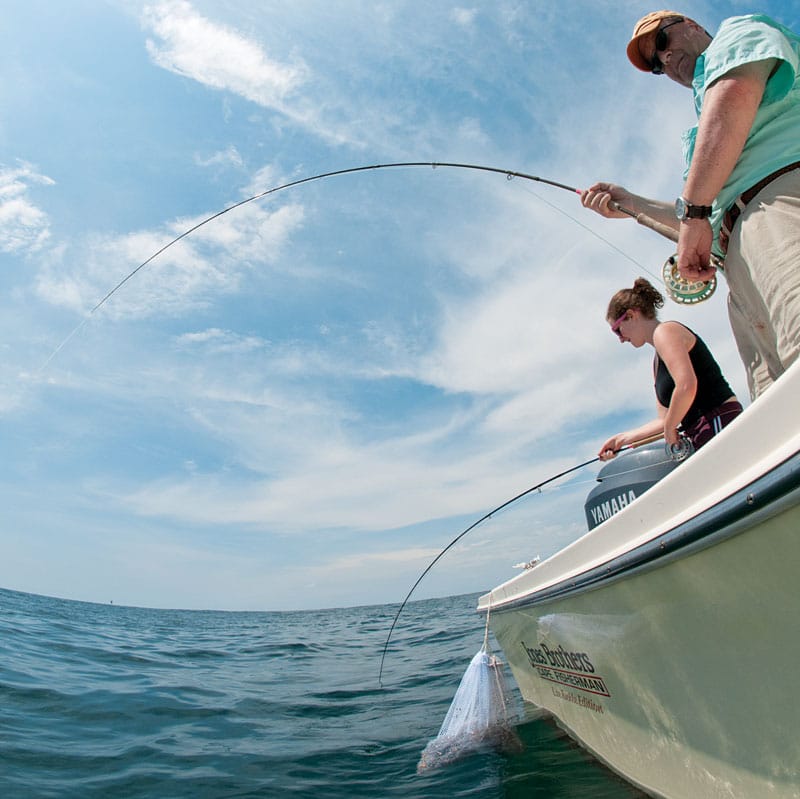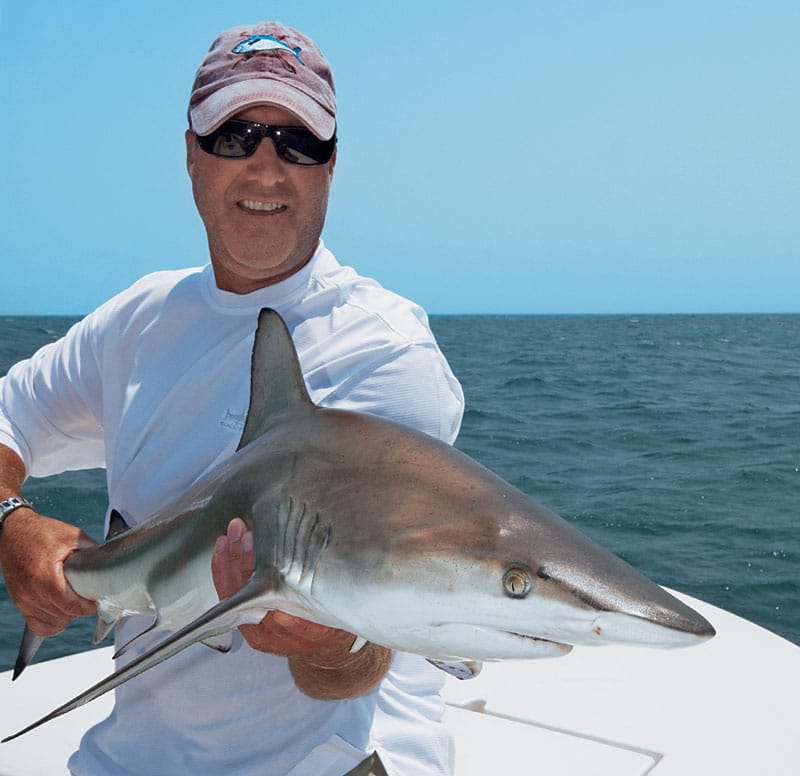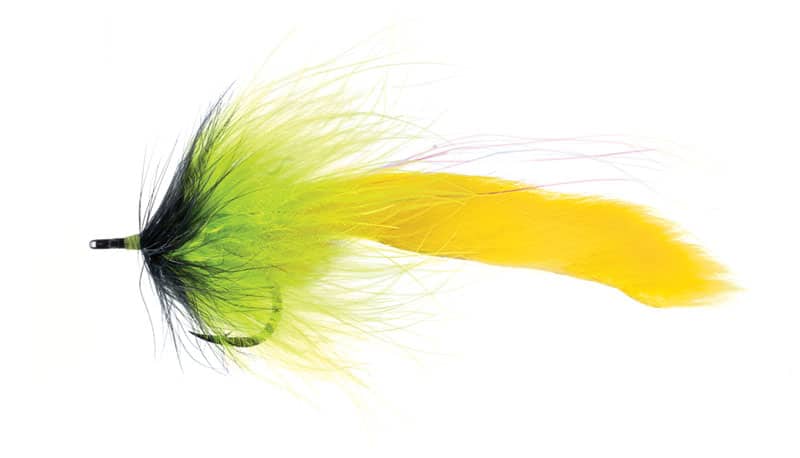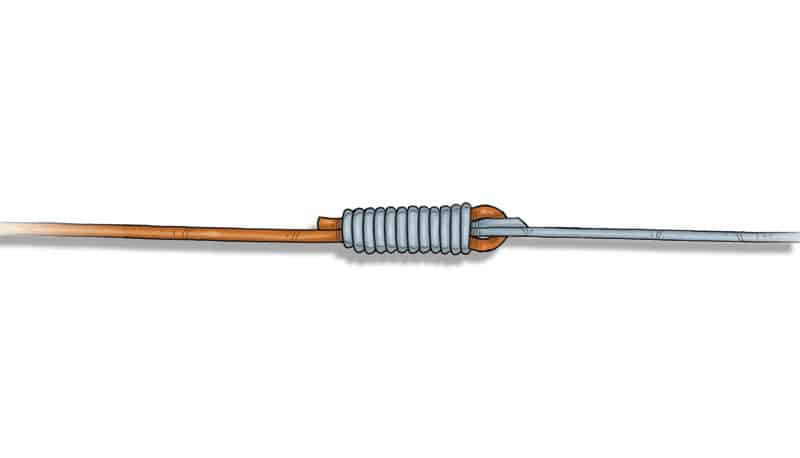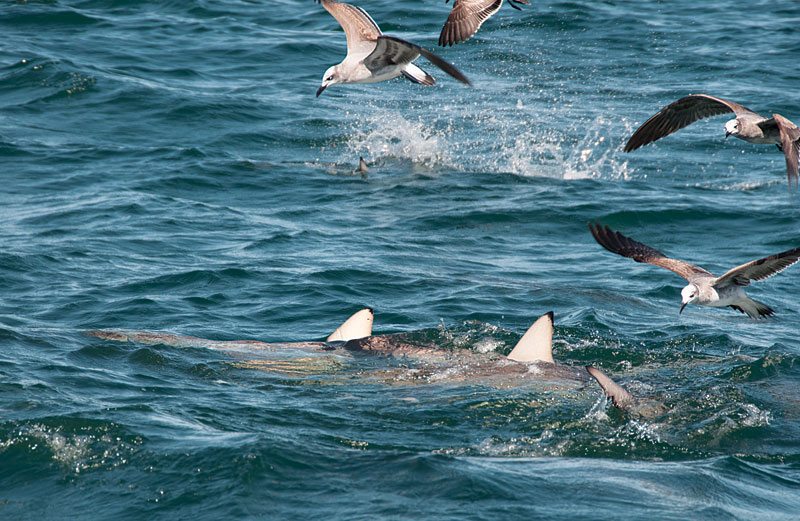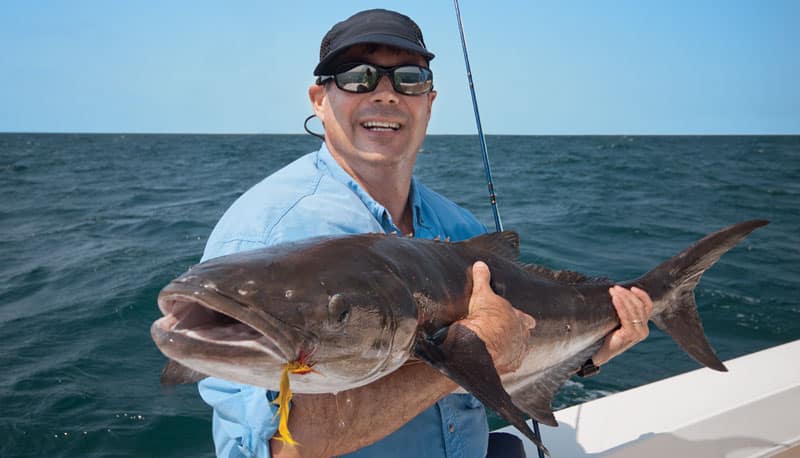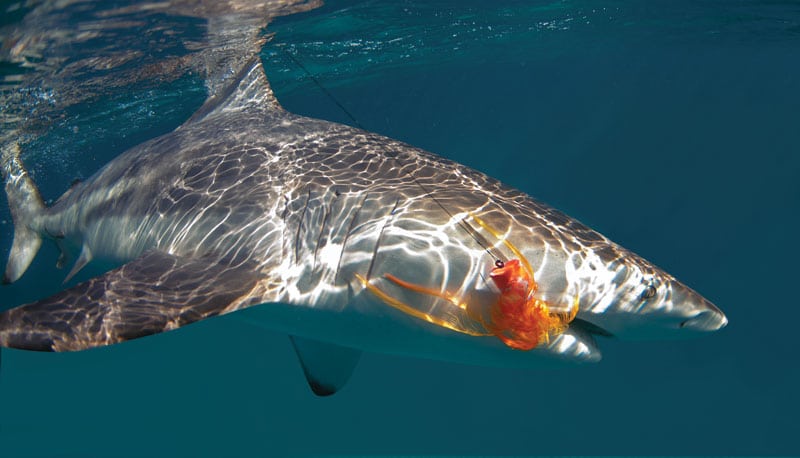
Mention fly-fishing for sharks to most people, and you will receive a blank stare. Sharks simply do not get the respect they deserve. But any fish that will eat flies, pull hard and throw in a few jumps has more than adequate credentials to be classified a game fish in my book.
Anglers in south Florida, the Florida Keys, and San Diego, California, discovered this ages ago and now have a long history of fly-fishing for sharks. We mid-Atlantic anglers may be a little slow to learn, but casting flies to these beautiful, toothy beasts is finally beginning to catch on here.
The waters out of and around Oregon Inlet, North Carolina, are best described as a migratory fishery — fish are heading either north or south. Intercepting one of the migrations can lead to the blitz fishing for which the area is known.
In early May, Outer Banks anglers gear up for the first push of warm water as it passes Cape Hatteras and Diamond Shoals. Normally by mid-May, the water temperatures north of Cape Hatteras are in the mid-60s to low 70s, and the water starts to move north up the beach toward Oregon Inlet and beyond. Temperatures in the mid-60s and rising signal the threadfin herring, menhaden and big striped anchovies to start their trek northward to their summer haunts. While most Outer Banks anglers focus on chasing cobia this time of year, there is a growing group of us who prefer to concentrate on sharks.
Hot on the tails of cobia is a multitude of toothy species nibbling at the shimmering buffet line. Packs of blacktip sharks are in close pursuit, along with scalloped hammerheads and Atlantic sharpnose, tiger and spinner sharks. The cobia aren’t just passing through. Like the sharks, they are also there to take advantage of the food and the warm current. They move northward into their summer spawning grounds in the mouth of the Chesapeake Bay. The bulk of these fish move through in June, but all summer packs of sharks and cobia inevitably search the warm water for an easy meal. Later in the season, when water temperatures steady out in the 70s, spinner and tiger sharks will make their presence known.
Bring On the Chum
Blacktips and their cousins feed in packs and often push schools of baitfish to the top, which adds an impressive visual element to this type of fishing. However, finding a school of sharks on a baitball can be a long process, especially when conditions aren’t favorable.
When the seas are choppy or you don’t have the sunlight you need to find the fish, it’s time to bring the fish to you by using chumming tactics.
Most anglers chum with fish carcasses or frozen blocks of ground fish. They put a chunk into a mesh bag, which is then lowered over the side of the boat. As the block thaws, pieces of the chum float away from the boat, making a slick. The quarry smell this slick and follow it.
In the mid-Atlantic, ground chum is made primarily of menhaden. Farther south, you can find frozen blocks of chum made from Spanish sardines, which are also excellent. Tuna, bonito, little tunny or dolphin carcasses also work well.
**
Where to Ride the Bag**
Once you have the chum and you’re in the ocean, the question becomes where to place the bag. There are several factors to consider. Water temperature is the most important, but water clarity, depth, bottom structure and tide lines all figure into the equation.
The most popular area for riding the bag around Oregon Inlet is from just outside the inlet south all the way to Cape Hatteras. The prime water temperature starts at around 66 degrees, but the action really turns on when the water approaches the 70-degree mark.
Tide lines or temperature changes are good places to start chumming. Tide lines are where two different currents of ocean water meet. Think of the ocean as a big stream with riffles, pools and different speeds of current. Where two different pieces of ocean butt together, there can be grass, weeds, foam or just a temperature break, or all of these. Any of this is considered structure. It may be floating, but it is structure, and structure is a hiding place for bait.
Sharks often cruise the edges of tide lines looking for an easy meal. In a perfect world, your drift would take you parallel to the tide line, with your chum drifting back to the edge.
But often tide lines are not visible. On those days, it’s good to know that sharks lurk in other places. They often cruise different depths looking for food. This is why drifting while chumming is so effective — you cover more area, and when you locate the sharks, you can concentrate your chumming in the depth that is holding fish.
Here’s a tip: Southwest winds are the prevailing winds in the summer. With a beach that runs north and south, this means a breeze blowing off land. You can set your drift in 30 feet of water, and the breeze will take you offshore into deeper water. The breeze is your friend in this fishery — nothing is worse than a slick-calm day with no boat movement and your chum sinking straight down over the side. To start the drift, hang the chum bag over the side and just under the surface. It is a good idea to keep the bag close to the boat, as it’s less likely to get stolen by your quarry. When you start seeing sharks in the slick, make a note of the depth and water temperature and add a waypoint or a track mark in your GPS plot line. When you quit seeing fish, make another mark and note the depth and temperature. This will help you dial in to the productive waters. Many times you will find the fish in a range of depths and temperatures.
A Reason to Believe
Mid-Atlantic sharking is one fly-fishery in which spinning rods are very helpful. Teasers floated back into the chum slick will entice a wary opponent into biting.
Teasers do not have to be fancy. Whole bait squid 4 to 7 inches work very well, as do eels. You can attach them to the line with a snap swivel, a short piece of wire or even a circle hook. If you can find bonito or little tunny, these cut into 6- to 8-inch-long and 1 ½-inch-wide strips make excellent teasers. It is in your best interest to secure the teasers firmly to the line. That way, if need be, you can pull one out of the mouth of a fish if it beats you to the rod.
When teasers are deployed, pay attention and fish them only as far back as you can see them. You must beat the fish to the teaser and reel in the teaser just ahead of the shark. Think of this fishery as a team sport — it helps to have at least two anglers involved, one to run the teaser and the other on the fly rod.
When the fish are near the bag, you can put up the teasers and grab a fly rod, or your partner can have the fly already in the water. Another trick for picky or timid sharks is to give them a “reason to believe.” Take chunks of squid or fish, and toss a few back in the slick. Think of these little bites as appetizers that will get your quarry excited enough to eat rabbit fur — which is usually not in their diet.
Fins in the Slick
Keep an eye on the slick, and watch the teasers. Sharks may come into the slick lazily, but don’t be fooled: When they want to be, they can be quick. Most do not require a lot of teasing, and the teaser can be removed from the water after they show up. If they need more convincing, retease them. If the visitors leave, they will usually return — they work slicks in a circular pattern.
Not all sharks are timid in a slick. Many times blacktips come into range supercharged, with their dorsal fin out of the water. These fish are ready to play. Blacktips are pack feeders, and those in a group will chase anything that is in the water. When spinners are on the feed, they can be aggressive and may chase poppers.
Presenting the fly is the easiest part of this operation. Make short casts, keep the fly where you can see it, and resist the temptation to move it — let it remain still. Most sharks prefer an almost stationary offering. Watch the fish: If it responds to a little movement, then keep moving the fly. If it spooks, stop moving the fly.
The best presentations are those in which the pattern is cast into the slick and not to the fish. For the most part, shark takes are subtle. A good strip strike is needed to set the hook. Once the hook has been set, the shark will jog off fairly fast, then circle the boat several times. When the time comes for the release, use a long dehooker or let every shark leave with a parting gift — the fly. That is why flies need to be easy to tie and not heirloom quality.
Remember, all sharks have teeth, so you need give them all the respect they deserve. Even the little guys can bite you and ruin a fun day.
Bonus Fish
A big bonus in chumming is that you do not know what might show up. Chumming attracts not only sharks but also other species. A well-outfitted crew is prepared for whatever swims up the slick.
If you find blacktips in May and June, keep your eyes open for a shark-looking critter that is slightly darker. At this time of year, the northern Outer Banks area is in the path of a significant cobia migration. These guys respond to chum and will breeze in to check out the scent.
Cobia are known to sneak in, and the first time you see one, it probably will be inches from your motor, just hanging out. These fish will go psycho over a teaser, particularly with a live or even dead eel, whole squid or live bunker. Cast the teasing rod just away from the boat but still within sight of the cobia, and move the teaser in front of the fish then pull it away. It may take several times to warm the target up, but the beast will come out.
It takes two anglers to do this next tango, but as the teaser is pulled, try casting the fly right beside the cobia. Hopefully when the teaser disappears, the cobia will eat the fly. This may take several attempts. When a cobia is present, slapping the fly onto the surface often will entice an eat better than gracefully landing the fly.
Keep in mind that not all cobia need to be teased; if you see them cruising around in the slick, coming toward the boat, by all means, throw them a fly. You can always tease them if they refuse.
Use a 9- to 11-weight rod with an intermediate or floating fly line with a 7- to 9-foot leader, 20-pound tippet and either 25- or 30-pound mono bite leader.
For cobia, use flies identical to shark flies, except in yellow and red.
Chumming has a long history in saltwater fly-fishing. Don’t let other people’s ideas of what fly-fishing is keep you from expanding your horizons. Take my advice: Ride the bag, sit back and let the action come to you.
TRIP PLANNER
Rods: Most of the sharks that show up in the slick can be handled with a 9- to 11-weight rod, and many with an 8-weight. For the most part, they are not monsters — usually 10 to 50 pounds, with an occasional bruiser.
Lines: Intermediate fly lines are the most versatile. Floating lines keep flies close to the surface, and at times a pattern here will draw more attention than a fly several feet under the water.
Leaders: Shark leaders should be simple. For example, a 7- to 10-foot tapered leader, in total, with 20-pound tippet plus a short bite tippet should be all you need.
Flies: Keep your flies basic — as a rule, it is one fish, one fly. Guides on the coast of North Carolina have found that 4-inch flies with a rabbit-strip tail and a crosscut rabbit-strip or marabou collar in bright colors work best.

